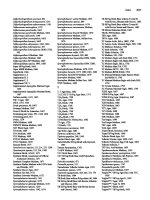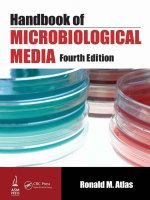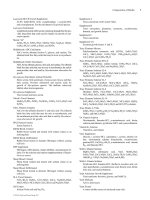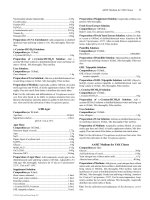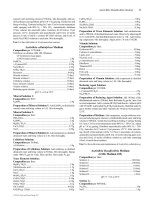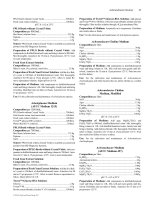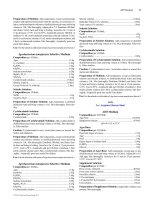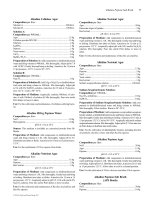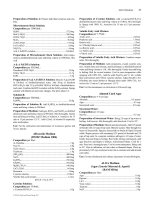Handbook of Microbiological Media, Fourth Edition part 92 potx
Bạn đang xem bản rút gọn của tài liệu. Xem và tải ngay bản đầy đủ của tài liệu tại đây (233.49 KB, 10 trang )
Kohn Two Tube HiVeg Medium No. 1 Base with Urea 905
sterile Petri dishes. Allow plates to dry in the dark at 30°C for 24 hr be-
fore using.
Use: For the isolation and cultivation of acidogenic microorganisms
from foods. For the differentiation of citrate-fermenting lactic bacteria,
such as Lactobacillus lactis subspecies diacetylactis, from the nonci-
trate-fermenting Lactobacillus lactis subspecies cremoris.
Knisely Medium for Bacillus anthracis
Composition per liter:
Beef heart, solids from infusion 500.0g
Agar 15.0g
Pancreatic digest of casein 10.0g
NaCl 5.0g
EDTA 200.0mg
Lysozyme 40.0mg
Thallous acetate 40.0mg
Polymyxin 30,000U
Preparation of Medium: Add components, except EDTA,
lysozyme, thallous acetate, and polymyxin, to distilled/deionized water
and bring volume to 1.0mL. Mix thoroughly. Gently heat and bring to
boiling. Adjust pH to 7.3. Autoclave for 15 min at 15 psi pressure–
121°C. Cool to 45°–50°C. Aseptically add sterile EDTA, lysozyme,
thallous acetate, and polymyxin. Mix thoroughly. Pour into sterile Petri
dishes or distribute into sterile tubes.
Use: For the cultivation and maintenance of Bacillus anthracis.
Koch’s K1 Medium
Composition per liter:
Glucose 1.8g
Peptone 0.6g
Yeast extract 0.4g
Preparation of Medium: Add components to distilled/deionized
water and bring volume to 1.0L. Mix thoroughly. Distribute into tubes
or flasks. Autoclave for 15 min at 15 psi pressure–121°C.
Use: For the cultivation of a variety of fungi.
Kohn Two Tube Medium No. 1 Base with Urea
Composition per liter:
Agar 16.0g
Peptic digest of animal tissue 15.0g
Mannitol 10.0g
Beef extract 2.0g
Yeast extract 2.0g
Glucose 1.0g
Phenol Red 0.05g
Urea solution 25.0mL
pH 7.3 ± 0.2 at 25°C
Source: This medium, without urea solution, is available as a pre-
mixed powder from HiMedia.
Urea Solution:
Composition
per 100.0mL:
Urea 5.0g
Preparation of Urea Solution: Add urea to distilled/deionized wa-
ter and bring volume to 100.0mL. Mix thoroughly. Filter sterilize.
Preparation of Medium: Add components to distilled/deionized
water and bring volume to 1.0L. Mix thoroughly. Gently heat and bring
to boiling. Distribute into tubes. Autoclave for 15 min at 10 psi pressure–
115°C. Cool to 60°C. Aseptically add 25mL of sterile urea solution.
Mix thoroughly. Allow to solidify as a slant in tubes with a genrous
butt.
Use: For the identification of Enterobacteriaceae on the basis of glu-
cose and mannitol fermentation and urease production.
Kohn Two Tube Medium No. 2
Composition per liter:
Casein enzymic hydrolysate 10.0g
Peptic digest of animal tissue 10.0g
Salicin 10.0g
Sucrose 10.0g
NaCl 5.0g
Agar 3.0g
Na
2
HPO
4
0.09g
Bromthymol Blue 0.02g
Na
2
S
2
O
3
0.016g
pH 7.3 ± 0.2 at 25°C
Source: This medium is available as a premixed powder from Hi-
Media.
Preparation of Medium: Add components to distilled/deionized
water and bring volume to 1.0L. Mix thoroughly. Gently heat and bring
to boiling. Distribute into tubes. Autoclave for 15 min at 10 psi pressure–
115°C. Allow to solidify in tubes in an upright position.
Use: For the identification of members of Enterobacteriaceae on the
basis of sucrose and salicin fermentation, motility, H
2
S production, and
indole production.
Kohn Two Tube HiVeg Medium No. 1 Base with Urea
Composition per liter:
Agar 16.0g
Plant peptone 15.0g
Mannitol 10.0g
Plant extract 2.0g
Yeast extract 2.0g
Glucose 1.0g
Phenol Red 0.05g
Urea solution 25.0mL
pH 7.3 ± 0.2 at 25°C
Source: This medium, without urea solution, is available as a pre-
mixed powder from HiMedia.
Urea Solution:
Composition
per 100.0mL:
Urea 5.0g
Preparation of Urea Solution: Add urea to distilled/deionized wa-
ter and bring volume to 100.0mL. Mix thoroughly. Filter sterilize.
Preparation of Medium: Add components to distilled/deionized
water and bring volume to 1.0L. Mix thoroughly. Gently heat and bring
to boiling. Distribute into tubes. Autoclave for 15 min at 10 psi pressure–
115°C. Cool to 60°C. Aseptically add 25.0mL of sterile urea solution.
Mix htoroughly. Allow to solidify as a slant in tubes with a genrous
butt.
Use: For the identification of Enterobacteriaceae on the basis of glu-
cose and mannitol fermentation and urease production.
© 2010 by Taylor and Francis Group, LLC
906 Kohn Two Tube HiVeg Medium No. 2
Kohn Two Tube HiVeg Medium No. 2
Composition per liter:
Plant hydrolysate 10.0g
Plant peptone 10.0g
Salicin 10.0g
Sucrose 10.0g
NaCl 5.0g
Agar 3.0g
Na
2
HPO
4
0.09g
Bromthymol Blue 0.02g
Na
2
S
2
O
3
0.016g
pH 7.3 ± 0.2 at 25°C
Source: This medium is available as a premixed powder from Hi-
Media.
Preparation of Medium: Add components to distilled/deionized
water and bring volume to 1.0L. Mix thoroughly. Gently heat and bring
to boiling. Distribute into tubes. Autoclave for 15 min at 10 psi pressure–
115°C. Allow to solidify in tubes in an upright position.
Use: For the identification of members of Enterobacteriaceae on the
basis of sucrose and salicin fermentation, motility, H
2
S production, and
indole production.
KoKo Medium
Composition per 1020.0mL:
K
2
HPO
4
1.6g
NaH
2
PO
4
·2H
2
O 1.0g
Peptone, meat 1.0g
Pancreatic digest of casein 1.0g
Yeast extract 1.0g
NH
4
Cl 0.5g
MgSO
4
·6H
2
O 0.16g
Resazurin 0.5mg
Glucose solution 100.0mL
NaHCO
3
solution 10.0mL
CaCl
2
·2H
2
O solution 10.0mL
L-Cysteine·HCl·H
2
O solution 10.0mL
Na
2
S·9H
2
O solution 10.0mL
Trace elements solution SL-4 10.0mL
Wolfe’s vitamin solution 10.0mL
pH 7.0 ± 0.2 at 25°C
Glucose Solution:
Composition
per 100.0mL:
D-Glucose 5.0g
Preparation of Glucose Solution: Add glucose to distilled/deion-
ized water and bring volume to 100.0mL. Mix thoroughly. Sparge with
100% N
2
. Autoclave for 15 min at 15 psi pressure–121°C.
NaHCO
3
Solution:
Composition
per 10.0mL:
NaHCO
3
1.0g
Preparation of NaHCO
3
Solution: Add NaHCO
3
to distilled/de-
ionized water and bring volume to 10.0mL. Mix thoroughly. Sparge
with 100% N
2
. Autoclave for 15 min at 15 psi pressure–121°C.
CaCl
2
Solution:
Composition
per 10.0mL:
CaCl
2
·2H
2
O 0.06g
Preparation of CaCl
2
Solution: Add CaCl
2
·2H
2
O to distilled/de-
ionized water and bring volume to 10.0mL. Mix thoroughly. Sparge
with 100% N
2
. Autoclave for 15 min at 15 psi pressure–121°C.
L-Cysteine·HCl·H
2
O Solution:
Composition
per 10.0mL:
L-Cysteine·HCl·H
2
O 0.3g
Preparation of L-Cysteine·HCl·H
2
O Solution: Add L-
cysteine·HCl·H
2
O to distilled/deionized water and bring volume to
10.0mL. Mix thoroughly. Sparge with 100% N
2
. Autoclave for 15 min
at 15 psi pressure–121°C.
Na
2
S·9H
2
O Solution:
Composition
per 10.0mL:
Na
2
S·9H
2
O 0.3g
Preparation of Na
2
S·9H
2
O Solution: Add Na
2
S·9H
2
O to dis-
tilled/deionized water and bring volume to 10.0mL. Mix thoroughly.
Sparge with 100% N
2
. Autoclave for 15 min at 15 psi pressure–121°C.
Before use, neutralize to pH 7.0 with sterile HCl.
Trace Elements Solution SL-4:
Composition
per liter:
EDTA 0.5g
FeSO
4
·7H
2
O 0.2g
Trace elements solution SL-6 100.0mL
Trace Elements Solution SL-6:
Composition
per liter:
MnCl
2
·4H
2
O 0.5g
H
3
BO
3
0.3g
CoCl
2
·6H
2
O 0.2g
ZnSO
4
·7H
2
O 0.1g
Na
2
MoO
4
·2H
2
O 0.03g
NiCl
2
·6H
2
O 0.02g
CuCl
2
·2H
2
O 0.01g
Preparation of Trace Elements Solution SL-6: Add components
to distilled/deionized water and bring volume to 1.0L. Mix thoroughly.
Preparation of Trace Elements Solution SL-4: Add compo-
nents to distilled/deionized water and bring volume to 1.0L. Mix thor-
oughly. Filter sterilize.
Wolfe’s Vitamin Solution:
Composition
per liter:
Pyridoxine·HCl 10.0mg
p-Aminobenzoic acid 5.0mg
Lipoic acid 5.0mg
Nicotinic acid 5.0mg
Riboflavin 5.0mg
Thiamine·HCl 5.0mg
Calcium
DL-pantothenate 5.0mg
Biotin 2.0mg
Folic acid 2.0mg
Vitamin B
12
0.1mg
Preparation of Wolfe’s Vitamin Solution: Add components to
distilled/deionized water and bring volume to 1.0L. Mix thoroughly.
Sparge with 100% N
2
. Filter sterilize.
Preparation of Medium: Prepare and dispense medium under
100% N
2
. Add components, except glucose solution, NaHCO
3
solu-
tion, CaCl
2
·2H
2
O solution, L-cysteine·HCl·H
2
O solution, Na
2
S·9H
2
O
solution, and Wolfe’s vitamin solution, to distilled/deionized water and
bring volume to 850.0mL. Mix thoroughly. Adjust pH to 7.0. Sparge
with 100% N
2
. Autoclave for 15 min at 15 psi pressure–121°C. Asep-
tically and anaerobically add 100.0mL of sterile glucose solution,
10.0mL of sterile NaHCO
3
solution, 10.0mL of sterile CaCl
2
·2H
2
O so-
lution, 10.0mL of sterile
L-cysteine·HCl·H
2
O solution, 10.0mL of ster-
ile Na
2
S·9H
2
O solution, and 10.0mL of sterile Wolfe’s vitamin
© 2010 by Taylor and Francis Group, LLC
KPL Medium 907
solution. Mix thoroughly. The pH should be 7.0. A buffer solution of
1% MOPS from a 10% anaerobic solution at pH 6.9–7.0 may be added
aseptically and anaerobically to enhance the buffer capacity of the me-
dium. Aseptically and anaerobically distribute into sterile tubes or bot-
tles.
Use: For the cultivation of Thermoanaerobacter italicus.
Korthof Medium
Composition per 1088.0mL:
NaCl 1.4g
Na
2
HPO
4
·2H
2
O 0.88g
Peptone 0.8g
KH
2
PO
4
0.24g
CaCl
2
0.04g
KCl 0.04g
NaHCO
3
0.02g
Rabbit serum, inactivated 80.0mL
Rabbit hemoglobin solution 8.0mL
pH 7.2 ± 0.2 at 25°C
Rabbit Hemoglobin Solution:
Composition
per 20.0mL:
Rabbit blood clot 10.0mL
Preparation of Rabbit Hemoglobin Solution: Add rabbit blood
clot to 10.0mL of distilled/deionized water. Lyse the clot by freezing
and thawing.
Preparation of Medium: Add components, except rabbit serum
and rabbit hemoglobin solution, to distilled/deionized water and bring
volume to 1.0L. Mix thoroughly. Gently heat and bring to boiling. Cool
to 25°C. Filter through Whatman #1 filter paper. Distribute into flasks
in 100.0mL volumes. Autoclave for 15 min at 15 psi pressure–121°C.
Cool to 45°–50°C. Aseptically add 8.0mL of rabbit serum and 0.8mL
of rabbit hemoglobin solution to each flask. Mix thoroughly.
Use: For the cultivation of Leptospira species.
Korthof Medium, Modified
Composition per liter:
NaCl 1.4g
Na
2
HPO
4
·2H
2
O 0.88g
Peptone 0.8g
KH
2
PO
4
0.24g
CaCl
2
0.04g
KCl 0.04g
NaHCO
3
0.02g
Rabbit serum, heat inactivated at 56°C 100.0mL
pH 7.2–7.6 at 25°C
Preparation of Medium: Add components, except rabbit serum, to
distilled/deionized water and bring volume to 900.0L. Mix thoroughly.
Gently heat and bring to boiling. Boil for 20 min. Cool overnight at
4°C. Filter through Whatman #2 filter paper. Distribute into tubes or
flasks. Autoclave for 15 min at 15 psi pressure–121°C. Cool to 50°–
56°C. Aseptically add 100.0mL of rabbit serum. Mix thoroughly.
Use: For the cultivation of Leptospira species.
Koser Citrate Broth
(BAM M72)
Composition per liter:
Sodium citrate 3.0g
NaNH
4
HPO
4
·4H
2
O 1.5g
KH
2
PO
4
1.0g
MgSO
4
·7H
2
O 0.2g
pH 6.7 ± 0.2 at 25°C
Source: This medium is available as a premixed powder from BD Di-
agnostic Systems.
Preparation of Medium: Add components to distilled/deionized
water and bring volume to 1.0L. Mix thoroughly. Gently heat and bring
to boiling. Distribute into tubes or flasks. Autoclave for 15 min at 15 psi
pressure–121°C. Pour into sterile Petri dishes or leave in tubes.
Use: For the differentiation of Escherichia coli and Enterobacter aero-
genes based on citrate utilization.
Koser Citrate Medium
Composition per liter:
Sodium citrate 3.0g
NaNH
4
HPO
4
·4H
2
O 1.5g
KH
2
PO
4
1.0g
MgSO
4
·7H
2
O 0.2g
pH 6.7 ± 0.2 at 25°C
Source: This medium is available as a premixed powder from BD Di-
agnostic Systems.
Preparation of Medium: Add components to distilled/deionized
water and bring volume to 1.0L. Mix thoroughly. Gently heat and bring
to boiling. Distribute into tubes or flasks. Autoclave for 15 min at 15
psi pressure–121°C. Pour into sterile Petri dishes or leave in tubes.
Use: For the differentiation of Escherichia coli and Enterobacter aero-
genes based on citrate utilization.
Kosmachev’s Medium
Composition per liter:
Agar 15.0g
CaCO
3
4.0g
KNO
3
1.0g
(NH
4
)
2
SO
4
1.0g
Na
2
HPO
4
1.0g
MgSO
4
·7H
2
O 0.5g
FeSO
4
·7H
2
O 0.01g
Yeast autolysate (30% solution) 15.0mL
Preparation of Medium: Add components to distilled/deionized
water and bring volume to 1.0L. Mix thoroughly. Gently heat and bring
to boiling. Distribute into tubes or flasks. Autoclave for 15 min at 15
psi pressure–121°C. Pour into sterile Petri dishes or leave in tubes.
Use: For the isolation and cultivation of Actinomadura species, Acti-
nopolyspora species, Excellospora species, and Microspora species.
KPL Medium
Composition per 1141.0mL:
Agar 15.0g
Galactose 10.0g
Glucose 10.0g
Lactic acid whey 1.0L
White table wine 140.0mL
Tween™ 80 1.0mL
pH 5.5 ± 0.2 at 25°C
Lactic Acid Whey:
Composition
per liter:
Skim milk (10% solution) 1.0L
© 2010 by Taylor and Francis Group, LLC
908 Kracke Blood Culture HiVeg Medium
Preparation of Lactic Acid Whey: Adjust the pH of the skim
milk to 5.5 with lactic acid. Gently heat and bring to boiling. Continue
boiling for 30 min. Filter through Whatman #1 filter paper.
Preparation of Medium: Combine components, except white table
wine. Mix thoroughly. Gently heat and bring to boiling. Adjust pH to
5.5. Autoclave for 15 min at 15 psi pressure–121°C. Cool to 45°–50°C.
Filter sterilize white table wine. To cooled, sterile basal medium, asep-
tically add sterile white table wine. Mix thoroughly. Pour into sterile
Petri dishes or distribute into sterile tubes.
Use: For the cultivation and maintenance of Lactobacillus kefiranofa-
ciens.
Kracke Blood Culture HiVeg Medium
Composition per liter:
NaCl 49.0g
Glucose 10.0g
Plant peptone No. 3 10.0g
Na
2
HPO
4
2.0g
Plant infusion 2.0g
Plant special infusion 1.0g
Sodium citrate 1.0g
pH 7.4 ± 0.2 at 25°C
Source: This medium is available as a premixed powder from Hi-
Media.
Preparation of Medium: Add components to distilled/deionized
water and bring volume to 1.0L. Mix thoroughly. Gently heat and bring
to boiling. Distribute into tubes or flasks. Autoclave for 15 min at 15
psi pressure–121°C.
Use: For the cultivation of pathogens in cases of bacteremia. The
medium is inoculated with blood from a patient. Approximately 10-
15mL of blood normally is inoculated into 50mL of medium.
Krainsky’s Asparagine Agar
Composition per liter:
Agar 15.0g
Glucose 10.0g
K
2
HPO
4
0.5g
L-Asparagine 0.5g
pH 7.0 ± 0.2 at 25°C
Preparation of Medium: Add components to distilled/deionized
water and bring volume to 1.0L. Mix thoroughly. Gently heat and bring
to boiling. Distribute into tubes or flasks. Autoclave for 15 min at 15
psi pressure–121°C. Pour into sterile Petri dishes or leave in tubes.
Use: For the cultivation and maintenance of Streptomyces fragmen-
tans.
KRANEP Agar Base
Composition per liter:
KSCN 25.5g
Agar 18.3g
Sodium pyruvate 8.2g
Pancreatic digest of gelatin 6.1g
LiCl 5.1g
Mannitol 5.1g
Beef extract 3.7g
NaN
3
0.05g
Cycloheximide 0.041g
Egg yolk emulsion 100.0mL
pH 6.8 ± 0.2 at 25°C
Caution: Sodium azide is toxic. Azides also react with metals and
disposal must be highly diluted.
Caution: Cycloheximide is toxic. Avoid skin contact or aerosol for-
mation and inhalation.
Source: This medium is available as a premixed powder from Oxoid
Unipath.
Egg Yolk Emulsion:
Composition
:
Chicken egg yolks 11
Whole chicken egg 1
Preparation of Egg Yolk Emulsion: Soak eggs with 1:100 dilu-
tion of saturated mercuric chloride solution for 1 min. Crack eggs and
separate yolks from whites. Mix egg yolks with 1 chicken egg.
Preparation of Medium: Add components, except egg yolk emul-
sion, to distilled/deionized water and bring volume to 900.0mL. Mix
thoroughly. Gently heat and bring to boiling. Autoclave for 15 min at
15 psi pressure–121°C. Cool to 45°–50°C. Aseptically add 100.0mL of
egg yolk emulsion. Mix thoroughly. Pour into sterile Petri dishes or
distribute into sterile tubes.
Use: For the isolation and enumeration of staphylococci from foods.
KRANEP HiVeg Agar Base with Egg Yolk Emulsion
Composition per liter:
Potassium thiocyanate 25.5g
Agar 15.0g
Sodium pyruvate 8.2g
LiCl 5.1g
Mannitol 5.1g
Plant peptone 5.0g
NaCl 5.0g
Plant extract 1.5g
Yeast extract 1.5g
NaN
3
0.05g
Cycloheximide 0.041g
Egg yolk emulsion 100.0mL
pH 6.8 ± 0.2 at 25°C
Source: This medium, without egg yolk emulsion, is available as a
premixed powder from HiMedia.
Caution: Sodium azide is toxic. Azides also react with metals and
disposal must be highly diluted.
Caution: Lithium Chloride is harmful. Avoid bodily contact and in-
halation of vapors. On contact with skin wash with plenty of water im-
mediately.
Caution: Cycloheximide is toxic. Avoid skin contact or aerosol for-
mation and inhalation.
Egg Yolk Emulsion:
Composition
per liter:
Egg yolks 30.0mL
NaCl, 0.9% solution 70.0mL
Preparation of Egg Yolk Emulsion: Soak eggs with 1:100 dilu-
tion of saturated mercuric chloride solution for 1 min. Crack 11 eggs
and separate yolks from whites. Mix egg yolks. Measure 30.0mL of
egg yolk emulsion and add to 70.0mL of 0.9% sterile NaCl solution.
Mix thoroughly. Warm to 45°–50°C.
© 2010 by Taylor and Francis Group, LLC
Kupferberg Trichomonas Broth 909
Preparation of Medium: Add components, except egg yolk emul-
sion, to distilled/deionized water and bring volume to 900.0mL. Mix
thoroughly. Gently heat and bring to boiling. Autoclave for 15 min at
15 psi pressure–121°C. Cool to 45°–50°C. Aseptically add 100.0mL of
egg yolk emulsion. Mix thoroughly. Pour into sterile Petri dishes or
distribute into sterile tubes.
Use: For the isolation and enumeration of staphylococci from foods.
Kreb’s Yeast Lactate Medium
Composition per liter:
Yeast extract 10.0g
Na
2
HPO
4
·2H
2
O 3.0g
KH
2
PO
4
1.0g
Sodium lactate solution 40.0mL
pH 7.0 ± 0.2 at 25°C
Sodium Lactate Solution:
Composition
per 100.0mL:
Sodium lactate 70.0g
Preparation of Sodium Lactate Solution: Add sodium lactate to
distilled/deionized water and bring volume to 100.0mL. Mix thorough-
ly. Filter sterilize.
Preparation of Medium: Add components, except sodium lactate
solution, to distilled/deionized water and bring volume to 960.0mL.
Mix thoroughly. Bring pH to 7.0. Autoclave for 15 min at 15 psi pres-
sure–121°C. Aseptically add 40.0mL of sterile sodium lactate solution.
Mix thoroughly. Aseptically distribute into sterile tubes or flasks.
Use: For the cultivation of Propionibacterium acidipropionici, Propi-
onibacterium freudenreichii, Propionibacterium intermedium, Propi-
onibacterium jensenii, Propionibacterium species, and Propionibacte-
rium thoenii.
Kundrant Agar
Composition per liter:
Agar 10.0g
Meat peptone 7.8g
Casein peptone 7.8g
Starch 4.0g
Gelatin 4.0g
NaCl 3.0g
Yeast extract 2.8g
Glucose 1.0g
Bromcresol Purple 1.6mg
pH 6.8 ± 0.2 at 25°C
Source: This medium is available from HiMedia.
Preparation of Medium: Add components to distilled/deionized
water and bring volume to 1.0L. Mix thoroughly. Gently heat and bring
to boiling. Distribute into tubes or flasks. Autoclave for 15 min at 15
psi pressure–121°C.
Use: For the qualitative detection of residues from sulfonamides and
other antimicrobics in animal-derived foods.
Kunkee Medium
Composition per 1000.88mL:
Pancreatic digest of casein 20.0g
Glucose 5.0g
Peptone 5.0g
Yeast extract 5.0g
Filtered tomato juice 250.0mL
Ethanol (96% solution) 176.0mL
Tween™ 80 0.5mL
pH 5.5 ± 0.2 at 25°C
Preparation of Medium: Add components, except ethanol, to dis-
tilled/deionized water and bring volume to 1.0L. Mix thoroughly. Dis-
tribute into tubes in 5.0mL volumes. Autoclave for 15 min at 15 psi
pressure–121°C. Cool to room temperature. Aseptically add 0.88mL of
ethanol solution to each tube containing 5.0mL of medium.
Use: For the cultivation of Lactobacillus fructivorans.
Kupferberg Trichomonas Base
Composition per liter:
Pancreatic digest of casein 20.0g
L-Cysteine·HCl·H
2
O 1.5g
Agar 1.0g
Maltose 1.0g
Methylene Blue 3.0mg
Bovine serum 50.0mL
pH 6.0 ± 0.2 at 25°C
Source: This medium is available as a premixed powder from BD Di-
agnostic Systems.
Preparation of Medium: Add components, except bovine serum,
to distilled/deionized water and bring volume to 950.0mL. Mix thor-
oughly. Gently heat and bring to boiling. Autoclave for 15 min at 15 psi
pressure–121°C. Cool to 45°–50°C. Aseptically add 50.0mL of bovine
serum. If desired, additional selectivity can be obtained by aseptically
adding 250,000U of penicillin and 1.0g of streptomycin or 1.0g of
chloramphenicol. Mix thoroughly. Pour into sterile Petri dishes or dis-
tribute into sterile tubes.
Use: For the cultivation of the Trichomonas species from clinical
specimens.
Kupferberg Trichomonas Broth
Composition per liter:
Enzymatic digest of protein 20.0g
L-Cysteine·HCl·H
2
O 1.5g
Agar 1.0g
Maltose 1.0g
Chloramphenicol 0.1g
Methylene Blue 3.0mg
Bovine serum 50.0mL
pH 6.0 ± 0.2 at 25°C
Source: This medium is available as a premixed powder from BD Di-
agnostic Systems.
Preparation of Medium: Add components, except bovine serum,
to distilled/deionized water and bring volume to 950.0mL. Mix thor-
oughly. Gently heat and bring to boiling. Autoclave for 15 min at 15 psi
pressure–121°C. Cool to 45°–50°C. Aseptically add bovine serum. If
desired, additional selectivity can be obtained by aseptically adding
250,000U penicillin and 1.0g streptomycin or 1.0g chloramphenicol.
Mix thoroughly. Pour into sterile Petri dishes or distribute into sterile
tubes.
Use: For the cultivation of the Trichomonas species from clinical speci-
mens.
© 2010 by Taylor and Francis Group, LLC
910 Kupferberg Trichomonas HiVeg Broth Base with Serum and Selective Supplement
Kupferberg Trichomonas HiVeg Broth Base
with Serum and Selective Supplement
(Trichomonas HiVeg Broth Base, Kupferberg)
Composition per liter:
Plant hydrolysate 20.0g
Agar 1.0g
L-Cysteine·HCl 1.5g
Maltose 1.0g
Methylene Blue 3.0mg
Bovine serum 50.0mL
Selective supplement 10.0mL
pH 6.0 ± 0.2 at 25°C
Source: This medium, without bovine serum and selective supple-
ment, is available as a premixed powder from HiMedia.
Selective Supplement Solution:
Composition
per 10.0mL:
Penicillin 250,000U
Preparation of Selective Supplement Solution: Add penicilliln
to distilled/deionized water and bring volume to 10.0mL. Mix thor-
oughly. Filter sterilize.
Preparation of Medium: Add components, except bovine serum
adn selective supplement, to distilled/deionized water and bring vol-
ume to 950.0mL. Mix thoroughly. Gently heat and bring to boiling.
Autoclave for 15 min at 15 psi pressure–121°C. Cool to 45°–50°C.
Aseptically add 50.0mL of bovine serum and 10.0mL selective supple-
ment.
Use: For the cultivation of Trichomonas species from clinical specimens.
Kupferberg Trichomonas HiVeg Broth Base
with Serum and Selective Supplement
(Trichomonas HiVeg Broth Base, Kupferberg)
Composition per liter:
Plant hydrolysate 20.0g
Agar 1.0g
L-Cysteine·HCl 1.5g
Maltose 1.0g
Methylene Blue 3.0mg
Bovine serum 50.0mL
Selective supplement 10.0mL
pH 6.0 ± 0.2 at 25°C
Source: This medium, without bovine serum and selective supple-
ment, is available as a premixed powder from HiMedia.
Selective Supplement Solution:
Composition
per 10.0mL:
Streptomycin 1.0g
Preparation of Selective Supplement Solution: Add strepto-
mycin to distilled/deionized water and bring volume to 10.0mL. Mix
thoroughly. Filter sterilize.
Preparation of Medium: Add components, except bovine serum
and selective supplement, to distilled/deionized water and bring vol-
ume to 950.0mL. Mix thoroughly. Gently heat and bring to boiling.
Autoclave for 15 min at 15 psi pressure–121°C. Cool to 45°–50°C.
Aseptically add 50.0mL of bovine serum and 10.0mL selective supple-
ment.
Use: For the cultivation of Trichomonas species from clinical speci-
mens.
Kupferberg Trichomonas HiVeg Broth Base
with Serum and Selective Supplement
(Trichomonas HiVeg Broth Base, Kupferberg)
Composition per liter:
Plant hydrolysate 20.0g
Agar 1.0g
L-Cysteine·HCl 1.5g
Maltose 1.0g
Methylene Blue 3.0mg
Bovine serum 50.0mL
Selective supplement 10.0mL
pH 6.0 ± 0.2 at 25°C
Source: This medium, without bovine serum and selective supple-
ment, is available as a premixed powder from HiMedia.
Selective Supplement Solution:
Composition
per 10.0mL:
Chloramphenicol 1.0g
Preparation of Selective Supplement Solution: Add chloram-
phenicol to distilled/deionized water and bring volume to 10.0mL. Mix
thoroughly. Filter sterilize.
Preparation of Medium: Add components, except bovine serum
adn selective supplement, to distilled/deionized water and bring vol-
ume to 950.0mL. Mix thoroughly. Gently heat and bring to boiling.
Autoclave for 15 min at 15 psi pressure–121°C. Cool to 45°–50°C.
Aseptically add 50.0mL of bovine serum and 10.0mL selective supple-
ment.
Use: For the cultivation of Trichomonas species from clinical speci-
mens.
Kushneria aurantia Medium
(DSMZ Medium 1195)
Composition per liter:
NaCl 78.0g
MgSO
4
·7H
2
O 20.3g
MgCl
2
·6H
2
O 13.0g
Yeast extract 5.0g
KCl 2.0g
CaCl
2
·2H
2
O 0.33g
NaBr 0.23g
NaHCO
3
0.06g
pH 7.3 ± 0.2 at 25°C
Preparation of Medium: Add components to distilled/deionized
water and bring volume to 1.0L. Mix thoroughly. Adjust pH to 7.3.
Distribute into tubes or flasks. Gently heat while stirring and bring to
boiling. Mix thoroughly. Autoclave for 15 min at 15 psi pressure–
121°C.
Use: For the cultivation of Kushneria aurantia.
KVBA
See: Kanamycin Vancomycin Blood Agar
KYE Agar
Composition per liter:
Agar 15.0g
NaNO
3
2.5g
KH
2
PO
4
1.0g
Yeast extract 1.0g
MgSO
4
·7H
2
O 0.3g
© 2010 by Taylor and Francis Group, LLC
L Diphasic Blood Agar Medium 911
CaCl
2
·6H
2
O 0.15g
NaCl 0.1g
FeCl
3
10.0mg
pH 10.0 ± 0.2 at 25°C
Preparation of Medium: Add components to distilled/deionized
water and bring volume to 1.0L. Mix thoroughly. Gently heat and bring
to boiling. Distribute into tubes or flasks. Autoclave for 15 min at 15
psi pressure–121°C. Pour into sterile Petri dishes or leave in tubes.
Use: For the cultivation of a variety of alkaliphilic bacteria.
L Agar
(Luria Agar)
Composition per liter:
Agar 15.0g
Pancreatic digest of casein 10.0g
Yeast extract 5.0g
NaCl 0.5g
Glucose solution 20.0mL
pH 7.0 ± 0.2 at 25°C
Glucose Solution:
Composition
per 100.0mL:
Glucose 10.0g
Preparation of Glucose Solution: Add glucose to distilled/deion-
ized water and bring volume to 100.0mL. Mix thoroughly. Filter ster-
ilize.
Preparation of Medium: Add components, except glucose solu-
tion, to distilled/deionized water and bring volume to 980.0mL. Mix
thoroughly. Bring pH to 7.0. Gently heat and bring to boiling. Auto-
clave for 15 min at 15 psi pressure–121°C. Aseptically add 20.0mL of
sterile glucose solution. Mix thoroughly. Pour into sterile Petri dishes
or leave in tubes.
Use: For the cultivation of Escherichia coli.
L Broth
(Luria Broth)
Composition per liter:
Pancreatic digest of casein 10.0g
NaCl 5.0g
Yeast extract 5.0g
Glucose 1.0g
pH 7.0 ± 0.2 at 25°C
Preparation of Medium: Add components to distilled/deionized
water and bring volume to 1.0L. Mix thoroughly. Distribute into tubes
or flasks. Autoclave for 15 min at 15 psi pressure–121°C.
Use: For the cultivation of Escherichia coli.
L Broth DAP Thymidine
Composition per liter:
Pancreatic digest of casein 10.0g
NaCl 5.0g
Yeast extract 5.0g
Diaminopimelic acid solution 10.0mL
Thymidine solution 10.0mL
pH 7.0 ± 0.2 at 25°C
Diaminopimelic Acid Solution:
Composition
per 10.0mL:
Diaminopimelic acid 0.1g
Preparation of Diaminopimelic Acid Solution: Add diamin-
opimelic acid to distilled/deionized water and bring volume to 10.0mL.
Mix thoroughly. Filter sterilize.
Thymidine Solution:
Composition
per 10.0mL:
Thymidine 0.01g
Preparation of Thymidine Solution: Add thymidine to distilled/
deionized water and bring volume to 10.0mL. Mix thoroughly. Filter
sterilize.
Preparation of Medium: Add components, except diaminopimelic
acid solution and thymidine solution, to distilled/deionized water and
bring volume to 980.0mL. Mix thoroughly. Bring pH to 7.0. Autoclave
for 15 min at 15 psi pressure–121°C. Aseptically add 10.0mL of sterile
diaminopimelic acid solution and 10.0mL of sterile thymidine solu-
tion. Mix thoroughly. Aseptically distribute into sterile tubes or flasks.
Use: For the cultivation of Escherichia coli.
L Diphasic Blood Agar Medium
(ATCC Medium 947)
Composition per 1150.0mL:
Blood agar, diphasic base medium 700.0mL
Rabbit blood, defibrinated 300.0mL
Locke’s solution 150.0mL
pH 7.2–7.4 at 25°C
Blood Agar, Diphasic Base Medium:
Composition
per 750.0mL:
Beef 25.0g
Agar 10.0g
Neopeptone 10.0g
NaCl 2.5g
Preparation of Blood Agar, Diphasic Base Medium: Trim
beef to remove fat. Add 25.0g of lean beef to 250.0mL of distilled/de-
ionized water. Gently heat and bring to boiling. Boil for 2–3 min. Filter
through Whatman #2 filter paper. Add agar, neopeptone, and NaCl to
filtrate. Bring volume to 750.0mL with distilled/deionized water. Mix
thoroughly. Adjust pH to 7.2–7.4. Gently heat and bring to boiling. Au-
toclave for 15 min at 15 psi pressure–121°C. Cool to 50°–55°C.
Locke’s Solution:
Composition
per liter:
NaCl 8.0g
Glucose 2.5g
KH
2
PO
4
0.3g
CaCl
2
0.2g
KCl 0.2g
Preparation of Locke's Solution: Add components to distilled/
deionized water and bring volume to 1.0L. Mix thoroughly. Autoclave
for 15 min at 15 psi pressure–121°C. Cool to 50°–55°C.
Preparation of Medium: Aseptically combine 700.0mL of sterile
blood agar, diphasic base medium, with 300.0mL of sterile defibrinat-
ed rabbit blood warmed to 50°–55°C. Mix thoroughly. Aseptically dis-
tribute 5.0mL volumes into 16 × 125mm screw-capped test tubes.
Allow to cool in a slanted position. Overlay the agar in each tube with
1.0mL of sterile Locke’s solution.
© 2010 by Taylor and Francis Group, LLC
912 L Diphasic Blood Agar Medium
Use: For the cultivation and maintenance of Trypanosoma species,
Leishmania donovani, Herpetomonas species, and Trypanosoma
neveulemairei.
L Diphasic Blood Agar Medium
(ATCC Medium 1011)
Composition per 1150.0mL:
Blood agar, diphasic base medium 700.0mL
Rabbit blood, defibrinated 300.0mL
Locke’s solution 150.0mL
pH 7.2–7.4 at 25°C
Blood Agar, Diphasic Base Medium:
Composition
per 750.0mL:
Beef 25.0g
Agar 10.0g
Neopeptone 10.0g
NaCl 2.5g
Preparation of Blood Agar, Diphasic Base Medium: Trim
beef to remove fat. Add 25.0g of lean beef to 250.0mL of distilled/de-
ionized water. Gently heat and bring to boiling. Boil for 2–3 min. Filter
through Whatman #2 filter paper. Add agar, neopeptone, and NaCl to
filtrate. Bring volume to 750.0mL with distilled/deionized water. Mix
thoroughly. Adjust pH to 7.2–7.4. Gently heat and bring to boiling. Au-
toclave for 15 min at 15 psi pressure–121°C. Cool to 50°–55°C.
Locke’s Solution:
Composition
per liter:
NaCl 8.0g
Glucose 2.5g
KH
2
PO
4
0.3g
CaCl
2
0.2g
KCl 0.2g
Preparation of Locke’s Solution: Add components to distilled/
deionized water and bring volume to 1.0L. Mix thoroughly. Autoclave
for 15 min at 15 psi pressure–121°C. Cool to 50°–55°C.
Preparation of Medium: Aseptically combine 700.0mL of sterile
blood agar, diphasic base medium, with 300.0mL of sterile defibrinat-
ed rabbit blood warmed to 50°–55°C. Mix thoroughly. Aseptically dis-
tribute 5.0mL volumes into 16 × 125mm screw-capped test tubes.
Allow to cool in a slanted position. Overlay the agar in each tube with
3.0mL of sterile Locke’s solution.
Use: For the cultivation and maintenance of Trypanosoma species.
L and F Basal Salts, Modified with Heptadecane
Composition per liter:
NH
4
Cl 2.0g
Na
2
HPO
4
0.21g
MgSO
4
·7H
2
O 0.2g
NaH
2
PO
4
0.09g
KCl 0.04g
CaCl
2
0.015g
FeSO
4
·7H
2
O 1.0mg
ZnSO
4
·7H
2
O 0.07mg
H
3
BO
3
0.01mg
MnSO
4
·5H
2
O 0.01mg
MoO
3
0.01mg
CuSO
4
·5H
2
O 5.0μg
Heptadecane 2.0mL
pH 7.2 ± 0.2 at 25°C
Preparation of Medium: Add components, except heptadecane, to
distilled/deionized water and bring volume to 1.0L. Mix thoroughly.
Gently heat and bring to boiling. Distribute equally into four 250.0mL
volumes. Autoclave for 15 min at 15 psi pressure–121°C. Cool to
60°C. Filter sterilize heptadecane. To one 250.0mL fraction of basal
salts, aseptically add 0.5mL of sterile heptadecane. Pour mixture into a
sterile blender. Homogenize slowly to mix heptadecane with basal salts
and not to create excess bubbles. Rapidly distribute medium to sterile
screw-capped tubes. Chill tubes quickly in an ice pack or in the refrig-
erator. Allow tubes to solidify in a slanted position.
Use: For the cultivation and maintenance of Thermoleophilum album
and Thermoleophilum minutum.
.
L Medium
(ATCC Medium 167)
Composition per liter:
Agar 20.0g
NaNO
3
2.0g
Na
2
HPO
4
0.21g
MgSO
4
·7H
2
O 0.2g
NaH
2
PO
4
0.09g
KCl 0.04g
CaCl
2
0.015g
FeSO
4
·7H
2
O 1.0mg
Salts solution 1.0mL
Salts Solution:
Composition
per 100.0mL:
ZnSO
4
·7H
2
O 7.0mg
H
3
BO
3
1.0mg
MnSO
4
·5H
2
O 1.0mg
MoO
3
1.0mg
CuSO
4
·5H
2
O 0.5mg
Preparation of Salts Solution: Add components to distilled/deion-
ized water and bring volume to 100.0mL. Mix thoroughly.
Preparation of Medium: Add components to distilled/deionized
water and bring volume to 1.0L. Mix thoroughly. Gently heat and bring
to boiling. Distribute into tubes or flasks. Autoclave for 15 min at 15
psi pressure–121°C. Pour into sterile Petri dishes or leave in tubes.
Use: For the cultivation and maintenance of Methylococcus capsula-
tus and Pseudomonas methanica.
L Medium
(ATCC Medium 1154)
Composition per liter:
Pancreatic digest of casein 10.0g
NaCl 5.0g
Yeast extract 5.0g
pH 7.0 ± 0.2 at 25°C
Preparation of Medium: Add components to distilled/deionized
water and bring volume to 1.0L. Mix thoroughly. Adjust pH to 7.0.
Distribute into tubes or flasks. Autoclave for 25 min at 15 psi pressure–
121°C.
Use: For the cultivation and maintenance of Escherichia coli.
L Medium with Ampicillin
Composition per liter:
Pancreatic digest of casein 10.0g
NaCl 5.0g
© 2010 by Taylor and Francis Group, LLC
L Medium with Methanol 913
Yeast extract 5.0g
Ampicillin solution 20.0mg
pH 7.0 ± 0.2 at 25°C
Ampicillin Solution:
Composition
per 10.0mL:
Ampicillin 0.02g
Preparation of Ampicillin Solution: Add ampicillin to distilled/
deionized water and bring volume to 10.0mL. Mix thoroughly. Filter
sterilize.
Preparation of Medium: Add components to distilled/deionized
water and bring volume to 1.0L. Mix thoroughly. Adjust pH to 7.0.
Distribute into tubes or flasks. Autoclave for 15 min at 15 psi pressure–
121°C.
Use: For the cultivation and maintenance of Escherichia coli.
L Medium with DAP and THY
(L Medium with Diaminopimelic Acid and Thymidine)
Composition per liter:
Pancreatic digest of casein 10.0g
NaCl 5.0g
Yeast extract 5.0g
Glucose solution 10.0mL
Diaminopimelic acid solution 10.0mL
Thymidine solution 10.0mL
pH 7.0 ± 0.2 at 25°C
Glucose Solution:
Composition
per 10.0mL:
D-Glucose 1.0g
Preparation of Glucose Solution: Add D-glucose to distilled/de-
ionized water and bring volume to 10.0mL. Mix thoroughly. Filter ster-
ilize.
Diaminopimelic Acid Solution:
Composition
per 10.0mL:
DL-Diaminopimelic acid 0.1g
Preparation of Diaminopimelic Acid Solution: Add diamin-
opimelic acid to distilled/deionized water and bring volume to 10.0mL.
Mix thoroughly. Filter sterilize.
Thymidine Solution:
Composition
per 10.0mL:
Thymidine 0.02g
Preparation of Thymidine Solution: Add thymidine to distilled/
deionized water and bring volume to 10.0mL. Mix thoroughly. Filter
sterilize.
Preparation of Medium: Add components—except glucose solu-
tion, diaminopimelic acid solution, and thymidine solution—to dis-
tilled/deionized water and bring volume to 970.0mL. Mix thoroughly.
Gently heat and bring to boiling. Adjust pH to 7.0. Autoclave for 15
min at 15 psi pressure–121°C. Cool to 45°–50°C. Aseptically add ster-
ile glucose solution, diaminopimelic acid solution, and thymidine so-
lution. Mix thoroughly. Aseptically distribute into sterile tubes or
flasks.
Use: For the cultivation and maintenance of Escherichia coli.
L Medium with DAP, THY, and AMP
(L Medium with Diaminopimelic
Acid, Thymidine, and Ampicillin)
Composition per liter:
Pancreatic digest of casein 10.0g
NaCl 5.0g
Yeast extract 5.0g
Diaminopimelic acid solution 10.0mL
Thymidine solution 10.0mL
Ampicillin solution 10.0mL
pH 7.0 ± 0.2 at 25°C
Diaminopimelic Acid Solution:
Composition
per 10.0mL:
DL-Diaminopimelic acid 0.1g
Preparation of Diaminopimelic Acid Solution: Add DL-di-
aminopimelic acid to distilled/deionized water and bring volume to
10.0mL. Mix thoroughly. Filter sterilize.
Thymidine Solution:
Composition
per 10.0mL:
Thymidine 0.04g
Preparation of Thymidine Solution: Add thymidine to distilled/
deionized water and bring volume to 10.0mL. Mix thoroughly. Filter
sterilize.
Ampicillin Solution:
Composition
per 10.0mL:
Ampicillin 0.02mg
Preparation of Ampicillin Solution: Add ampicillin to distilled/
deionized water and bring volume to 10.0mL. Mix thoroughly. Filter
sterilize.
Preparation of Medium: Add components—except ampicillin so-
lution, diaminopimelic acid solution, and thymidine solution—to dis-
tilled/deionized water and bring volume to 970.0mL. Mix thoroughly.
Gently heat and bring to boiling. Adjust pH to 7.0. Autoclave for 15
min at 15 psi pressure–121°C. Cool to 45°–50°C. Aseptically add ster-
ile ampicillin solution, diaminopimelic acid solution, and thymidine
solution. Mix thoroughly. Aseptically distribute into sterile tubes or
flasks.
Use: For the cultivation and maintenance of Escherichia coli.
L Medium with Diaminopimelic Acid and Thymidine
See: L Medium with DAP and THY
L Medium with Diaminopimelic
Acid, Thymidine, and Ampicillin
See: L Medium with DAP, THY, and AMP
L Medium with Methanol
Composition per liter:
Agar 20.0g
NaNO
3
2.0g
Na
2
HPO
4
0.21g
MgSO
4
·7H
2
O 0.2g
NaH
2
PO
4
0.09g
KCl 0.04g
CaCl
2
0.015g
FeSO
4
·7H
2
O 1.0mg
Methanol 20.0mL
Salts solution 1.0mL
© 2010 by Taylor and Francis Group, LLC
914 L Medium for Salmonella
Salts Solution:
Composition
per 100.0mL:
ZnSO
4
·7H
2
O 7.0mg
H
3
BO
3
1.0mg
MnSO
4
·5H
2
O 1.0mg
MoO
3
1.0mg
CuSO
4
·5H
2
O 0.5mg
Preparation of Salts Solution: Add components to distilled/deion-
ized water and bring volume to 100.0mL. Mix thoroughly.
Preparation of Medium: Add components, except methanol, to
distilled/deionized water and bring volume to 980.0mL. Mix thorough-
ly. Gently heat and bring to boiling. Autoclave for 15 min at 15 psi
pressure–121°C. Cool to 45°–50°C. Filter sterilize methanol. Asepti-
cally add 20.0mL of sterile methanol to cooled, sterile basal medium.
Mix thoroughly. Pour into sterile Petri dishes or distribute into sterile
tubes.
Use: For the cultivation and maintenance of Methylobacillus glyco-
genes.
L Medium for Salmonella
Composition per liter:
Pancreatic digest of casein 10.0g
NaCl 5.0g
Yeast extract 5.0g
Glucose 1.0g
pH 7.2 ± 0.2 at 25°C
Preparation of Medium: Add components to distilled/deionized wa-
ter and bring volume to 1.0L. Mix thoroughly. Adjust pH to 7.2. Distribute
into tubes or flasks. Autoclave for 15 min at 15 psi pressure–121°C.
Use: For the cultivation and maintenance of Salmonella choleraesuis.
L Medium with Tetracycline
Composition per liter:
Pancreatic digest of casein 10.0g
NaCl 5.0g
Yeast extract 5.0g
Tetracycline solution 10.0mL
pH 7.0 ± 0.2 at 25°C
Tetracycline Solution:
Composition
per 10.0mL:
Tetracycline 0.02mg
Preparation of Tetracycline Solution: Add tetracycline to dis-
tilled/deionized water and bring volume to 10.0mL. Mix thoroughly.
Filter sterilize.
Preparation of Medium: Add components, except tetracycline so-
lution, to distilled/deionized water and bring volume to 990.0mL. Mix
thoroughly. Gently heat and bring to boiling. Adjust pH to 7.0. Auto-
clave for 15 min at 15 psi pressure–121°C. Cool to 45°–50°C. Asepti-
cally add sterile tetracycline solution. Mix thoroughly. Aseptically
distribute into sterile tubes or flasks.
Use: For the cultivation and maintenance of Escherichia coli.
L15 Medium, Modified Leibovitz
Composition per liter:
NaCl 8.0g
DL-Threonine 0.6g
Sodium pyruvate 0.6g
DL-Alanine 0.5g
L-Arginine, free base 0.5g
KCl 0.4g
L-Asparagine·H
2
O 0.3g
L-Histidine, free base 0.3g
L-Glutamine 0.3g
L-Isoleucine 0.3g
L-Phenylalanine 0.3g
L-Tyrosine 0.3g
DL-Methionine 0.2g
DL-Valine 0.2g
Glycine 0.2g
L-Serine 0.2g
Na
2
HPO
4
, anhydrous 0.2g
CaCl
2
, anhydrous 0.1g
L-Cysteine, free base 0.1g
L-Leucine·HCl 0.1g
MgCl
2
, anhydrous 0.094g
D-Galactose 0.09g
KH
2
PO
4
0.06g
L-Tryptophan 0.02g
Phenol Red 0.01g
i-Inositol 2.0mg
Choline chloride 1.0mg
D-Calcium pantothenate 1.0mg
Folic acid 1.0mg
Nicotinamide 1.0mg
Pyridoxine·HCl 1.0mg
Thiamine monophosphate·2H
2
O 1.0mg
Riboflavin-5-phosphate 0.1mg
pH 7.5 ± 0.2 at 25°C
Preparation of Medium: Add components to distilled/deionized
water and bring volume to 1.0L. Mix thoroughly. Filter sterilize. Store
at 5°C.
Use: For the cultivation of oysters used for the growth of enterovi-
ruses.
L. mono Confirmatory Agar Base
(Listeria monocytogenes Confirmatory Agar, Base)
Composition per liter:
Special peptone 30.0g
Agar 12.0g
LiCl 10.0g
B.C. indicator 8.6g
Yeast extract 6.0g
NaCl 5.0g
α-Methyl-
D-mannoside 3.0g
Na
2
HPO
4
, anhydrous 2.5g
Listeria mono enrichment supplement II 10.0mL
Listeria mono selective supplement I 10.0mL
Listeria mono selective supplement II 10.0mL
pH 7.2 ± 0.2 at 25°C
Source: This medium, without Listeria mono enrichment supplement
II, Listeria mono selective supplement I, and Listeria mono selective
supplement II, is available as a premixed powder from BioChemika.
Caution: LiCl
is harmful. Avoid bodily contact and inhalation of va-
pors. On contact with skin wash with plenty of water immediately.
© 2010 by Taylor and Francis Group, LLC
